

 |
 |
click on thumbnail to enlarge
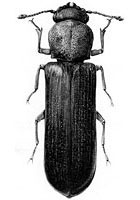
Lyctus planicollis LeConte
Drawing modified from Gerberg 1957
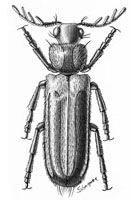
Stenomera sp.
Drawing © M.A. Ivie
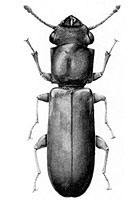
Trogoxylon parallelopipedum (Melsheimer)
Drawing © M.A. Ivie
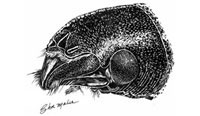
Melalgus sp., head
Drawing © M.A. Ivie
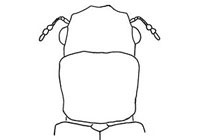
Melalgus sp., head
Drawing © M.A. Ivie
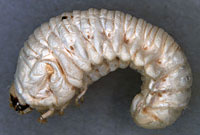
Bostrichus capucinus (L.), lateral view
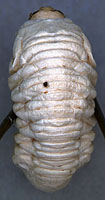
Bostrichus capucinus (L.), dorsal view
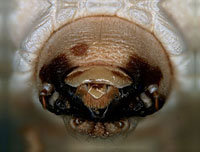
Bostrichus capucinus (L.), head
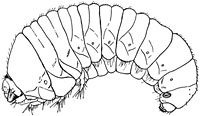
Lyctus sp., lateral view
Drawing modified from Bøving & Craighead 1931

Psoa maculata (LeConte)
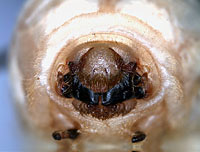
Polycaon stoutii (LeConte), head
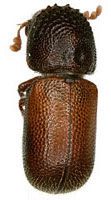
Dinoderus minutus (Fabricius)
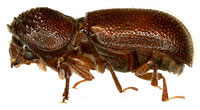
Dinoderus minutus (Fabricius)

Bostrichus capucinus (L.)
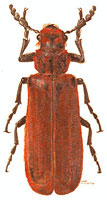
Coccographus sp.
Drawing © M.A. Ivie

Coccographus sp., head
Drawing © M.A. Ivie

Psoidia sp.
Drawing © M.A. Ivie
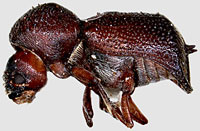
Sinoxylon anale Lesne

Psoa sp.
Drawing © M.A. Ivie

Psoa sp.
Drawing © M.A. Ivie

Dinapate sp.
Drawing © M.A. Ivie
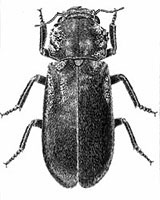
Dysides sp.
Drawing © M.A. Ivie

Dysides sp.
Drawing © M.A. Ivie
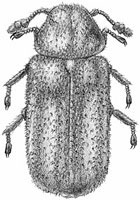
Endecatomus sp.
Drawing © M.A. Ivie
powder-post beetles, bostrichid beetles, twig and wood borers
Global
~100 genera with ~500 species.
Adult: Body shape typically elongate cylindrical and moderately to distinctly convex, rarely moderately to distinctly flattened. Size ranges from 2-50mm in length, most less than 20mm long. Most genera variable from yellow, brown or black, some with metallic hue. Head usually deflexed under hood-like pronotum and not visible from above. Antennae 8-11 segmented, typically ending in a 2, 3 or 4 segmented club, rarely appearing lamellate. Mandibles large and prominent, variable from blunt to bifid apically. Pronotum often cowled along anterior margin, or straight, flat and/or smooth. Tarsal formula 5-5-5, rarely 4-4-4 (e.g., Psoa). Elytra usually coarsely punctate, sometimes with costae present. Hindwing well-developed, R3 short and attached directly to RP from the RP-MP2 cross-vein; well-developed R-cell present. Abdomen typically with five visible abdominal segments, rarely 6.
Larva: Body lightly sclerotized, white to yellowish in color, "C-shaped" (scarabaeoid), elongate, cylindrical to somewhat flattened, and typically averaging between 2-60mm in length. Vestiture typically short and fine, sometimes with elongate setal patches. Legs are well-developed. Head typically retracted into prothorax and prognathous (except Endecatomus). Prothorax typically more enlarged than either meso- or metathorax. Abdominal segments 1-8 usually with well-developed pleural lobes. Longitudinally (most) or transverse (Lyctinae) oval pads located beneath the anal opening. Thoracic spiracles located posteriorly on the prothorax or on mesothorax. Abdominal terga without patches of asperities, but some transverse plicae may be present.
Bostrichid beetles are well-known pests of wood and wood products,
including seasoned lumber and furniture products. Some attack monocotyledonous
plants as well (e.g., some Lyctinae and Dinoderinae). The lesser grain
borer, Rhizopertha dominica (F.), has become a ubiquitous pest
of stored grains and cereal products. Dunnage beetles in the genus Sinoxylon have become problematic and are becoming more ubiquitous through transport
via wooden pallets and shipping crates (solid wood packing material [SWPM]). In North America other genera
have become pestiferous on varied commodities, including: Bostrichoplites, Dinoderus, Heterobostrychus, Melalgus, and Prostephanus.
Key player modified February 2018
Content last modified: February 4, 2011